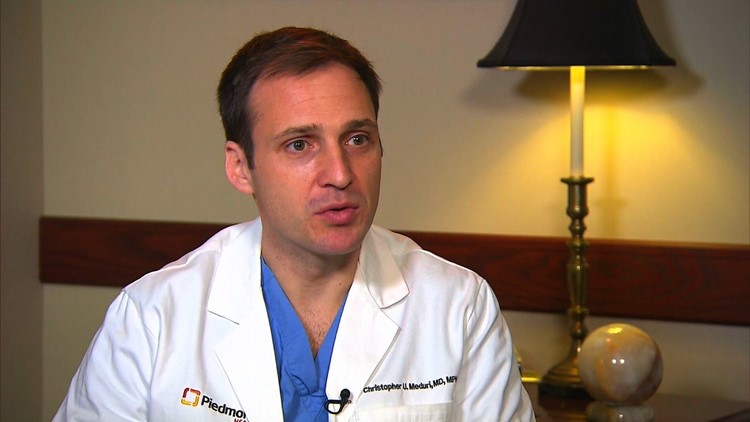What you probably don’t know about heart attacks can kill you. Working out every day and eating healthy doesn’t mean you’re immune to the leading killer of men and women in the United States.
Alex Small started his 37th birthday last September the same as any other day. “I wake up at 4:30 or 5:30 in the morning, and go work out. Work out for about an hour, come home, eat breakfast, shower and go to work.”
That morning, after having breakfast with his wife and two children, Small started to feel a burning sensation and discomfort in his chest, the most common heart attack symptom for men and women. He started to worry as it became more persistent while he drove to work. Then came a little chest pressure, and he wasn’t able to breathe full and deep breaths.
“In the back of my mind, I was thinking maybe I had eaten something and was having an allergic reaction,” Small recalled. “Maybe I pulled a muscle from working out.”
He was actually having a major heart attack. He knew about the symptoms of a heart attack — his wife works with heart surgery patients in a hospital. But between his healthy lifestyle and lack of family history of heart disease, it just didn’t occur to him.
Knowing the symptoms of a heart attack
According to the American Heart Association, warning signs and symptoms besides chest discomfort and shortness of breath include discomfort in other areas of the upper body, breaking out in a cold sweat, nausea or lightheadedness.
Because symptoms can include chest pressure, not just pain, people often think it’s just indigestion. People need to be conscious of all the symptoms, especially if they already have risk factors of cardiovascular disease. Minutes matter when it comes to anyone having a heart attack. Often people affected aren’t sure what’s wrong and wait too long before seeking help. The longer you wait, the more heart or brain tissue dies, and the greater the likelihood of death or disability. About every 43 seconds, someone in the United States has a heart attack.
Small pulled his car into a parking lot but then thought, “If this is bad, this is the last place I want to be, because nobody is here.” He then pulled into a gas station nearby to get an aspirin, hoping to relieve some of the discomfort. Aspirin “thins” the blood and helps prevent blood clots from forming. It’s a common thought for many when experiencing discomfort.
By that time, Small was starting to sweat and feeling more pressure in his chest. He also felt dizzy. Small passed out at the gas station, and an ambulance was quickly called.
Small was in cardiac arrest and was rushed to Piedmont Hospital in Atlanta, where Dr. Christopher Meduri, an interventional cardiologist, took over care. A father of four young children himself and the same age as his patient, Meduri immediately related to Small’s case.
By going through Small’s wrist, in a process known as radial cardiac catheterization, doctors were able to take pictures of his heart. What they found was blockage in the left anterior descending artery, an area called the “widowmaker” because blockages at the beginning of its course can shut the whole artery down. Meduri was able to quickly get that artery back open, and stented it.
The sooner a patient gets to an emergency room, the sooner he or she can receive treatment to prevent total blockage and heart muscle damage or reduce the amount of damage. “It really builds on the idea that people must identify their symptoms quickly, and address them quickly,” Meduri added.
Small’s heart function was only 20% to 25% after the procedure, said Meduri. “We usually have (the patient) take it easy for the first month or two afterward.” With medication, cardiac rehab and the help of a special heart monitor, within a month Small had almost a full recovery of his heart function. By three months, his heart had fully normalized.
Who’s at risk?
The risk of a heart attack climbs for men after age 45 and for women after age 55. Small had no heart disease history in his family, normally another risk factor.
With Small being so physically active, Meduri said he thinks the strength of Small’s heart, independent of his heart attack, boded well for his recovery. Meduri said it doesn’t appear that there would be any direct correlation with Small’s vigorous exercise activities and his risk of heart attack. The best guess is that he is that one person out of 1,000 who may have a higher risk by doing higher intensity workouts.
According to Meduri, having a healthy heart revolves around two things: diet and exercise. “We want to really make sure we are having a healthy heart diet with controlling the salt intake we have in our diet, and fat intake as well. Someone should also be active and participate in at least 30 minutes of cardiovascular activity four to five times per week. Also, if someone does have high blood pressure or high cholesterol, or diabetes, (it’s important) to really have these things under control,” Meduri added.
Now friends, Small and Meduri plan to run their first 5K together. As Small pushes himself to that level for the first time since the heart attack (he has run marathons in the past), it will be reassuring to have his cardiologist right by his side.



